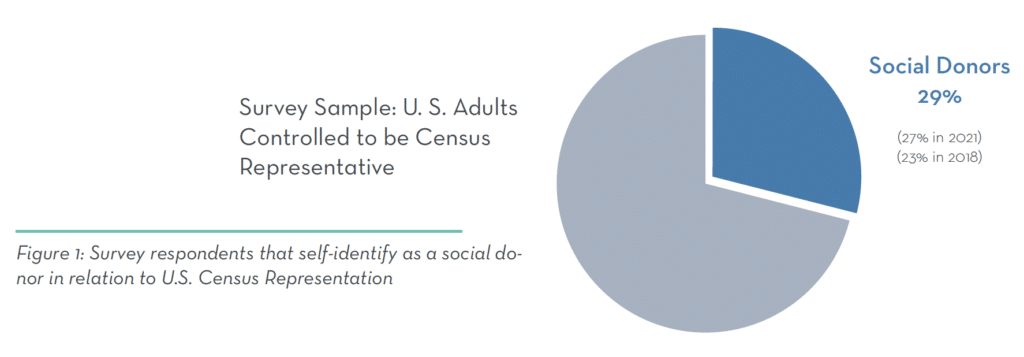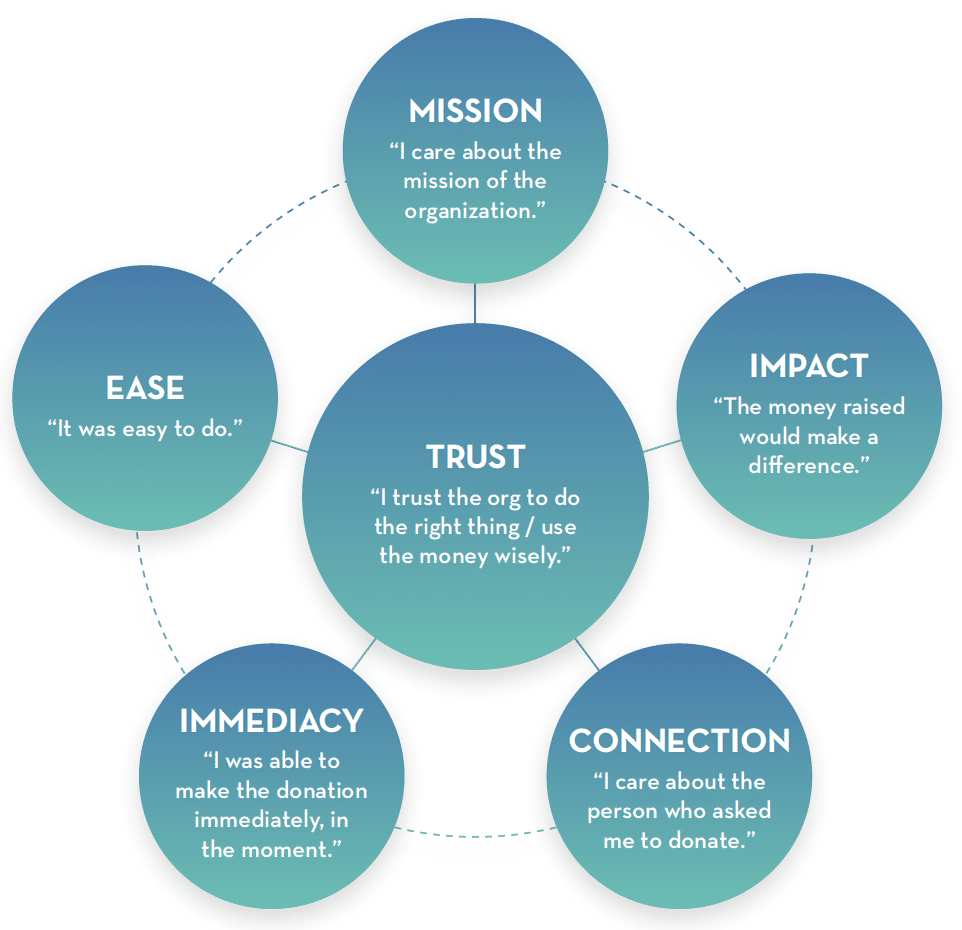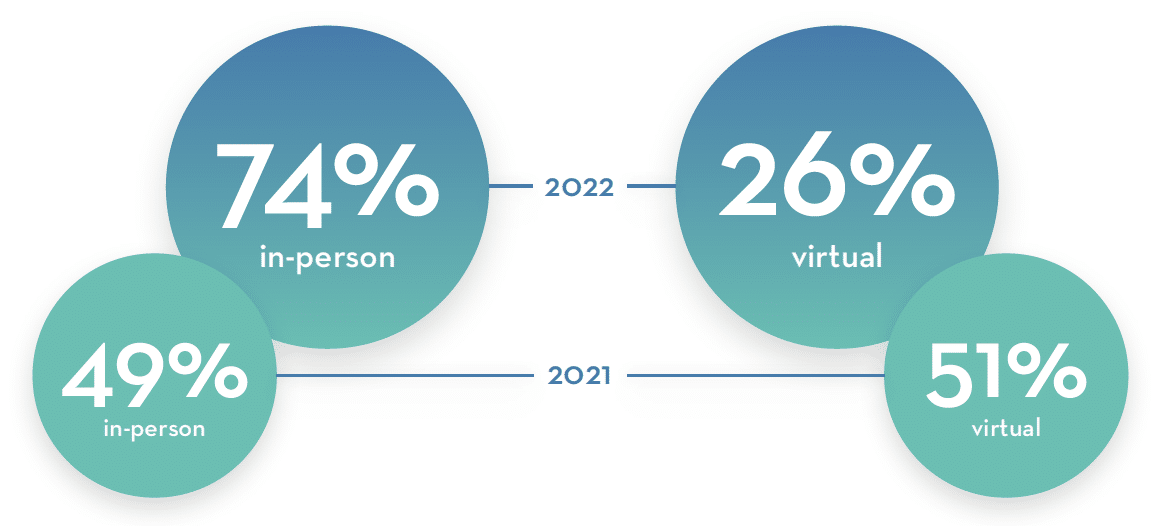The Evolution of The Donor Experience: What You Need to Know
Five years ago (2018), OneCause released its first Social Donor Study which examined the giving experience of donors who participated in auction events, peer-to-peer fundraising, occasions/challenges, and giving/awareness days. The research was groundbreaking because it provided a glimpse into the mindset, motivators, and behaviors of today’s donors, as reported by the donors themselves.
A second report (The Giving Experience: Social Giving in a Time of Social Distancing) was released in 2021, tracking trends of social giving during the pandemic. This year, in 2022, we released The Giving Experience: Understanding Evolving Donor Expectations to provide longitudinal comparison data on all three Social Donor reports.
The goal of these findings is to help nonprofits and fundraisers like you navigate and understand what makes today’s donors tick, stick, and stay.
There’s no denying the future of fundraising is an altered landscape. But there’s hope if we embrace what today’s donors are looking for!
Let’s dive into the 2022 key research findings and how you can use them create a giving experience that drives generosity:
- Social giving continues to grow
- Trust is at the center of the generosity ecosystem
- Ease, mission, impact remain as key motivators
- Donors are excited to return to in-person events
- Social giving attracts younger and more diverse
- Multi-channel marketing is key
- There are opportunities for retention and recurring giving
Social Giving Continues to Grow
The Giving Experience 2022 study focuses on the motivations, expectations, and behaviors of social donors who:
- Donated to or attended a fundraising event like a gala or auction,
- Sponsored someone or participated in a peer-to-peer fundraiser like a walk, run, ride, or
- Donated to fundraised as part of a fundraising challenge, occasion, or giving day.
Approximately 29% of U.S. adults surveyed self-identified as a social donor in 2022. When you do the math, that means there were approximately 96.4 million people who participated in social giving in the 12 months prior to the 2022 survey. This continues an upward trend in social giving participation, which has risen 6% since 2018.
With more social donors giving to more organizations than ever before, it’s the perfect opportunity for your organization to reach, engage, and retain donors. There’s army of energized givers is waiting to connect with you. You just need the right strategies to engage them!
The key lies in tapping into the unique motivators driving generosity for today’s social donors. For them to not only give, but stick around, nonprofits must:
- Design giving experiences that meet donors where they are
- Account for their evolving preferences
- Build choice into the donor journey
The pandemic changed so much about our lives, including donor’s expectations for giving. It’s important that the giving experience evolves and keeps pace with changing donor expectations.
Trust is at The Center of The Generosity Ecosystem
Since our first social donor study in 2018, the top motivators driving social giving have consistently been ease, mission, and impact. This year, trust moved into the number one spot with 6 in 10 donors indicating it’s the most important factor when choosing to donate to a nonprofit. Trust was closely followed by a tie at 58% between connection to the mission, ease, and immediacy.
With such a range of motivators driving donors, it’s helpful to view them as an ecosystem.
Building an easy, frictionless giving process, creating a community of donors that’s welcoming and inclusive, effectively sharing your organization’s mission, and consistently conveying impact are all part of creating the ultimate generosity motivator: trust.
So, how can you foster trust with your current and future donors?
- Easy giving: We trust things that are straightforward, seamless, and uncomplicated. An easy giving experience creates a sense of trust that your nonprofit is professional and worthy of donor time and dollars.
- Storytelling: Use stories to share the impact that your organization has on your community and be sure to tell them everywhere – in your donor communications, impact statements, on social media, in your nonprofit event marketing, and events.
- Impact statements: Be sure to include how reaching your fundraising goals will impact the beneficiaries of your cause. (Example: $100 will feed a family of 6 for 2 weeks or $150 will provide new desks for our Kindergarten class).
- Thank you messaging: When it comes to fundraising, the follow-up is just as, if not more important, than the original ask. Be specific when following up and thanking donors by including exactly how their donation was used to further your mission.
After a turbulent couple of years, social donors are looking to nonprofits for reassurance that donations are being put to good use and that organizations are acting with integrity. Keeping this in mind as you plan your messaging and fundraising will go a long way to garner trust and connection with today’s donors.
Ease, Mission, Impact Remain Key Motivators
In addition to trust, ease, mission, and impact continue to be the secret recipe to creating a strong giving experience.
Let’s break it down – ready?
- Ease: Simplify your donation process. With the right fundraising technology, nonprofits can create intuitive and fast giving experience that makes it easy to donate and ask for donations.
- Mission: Find your ‘wow’ factor – something unique about your mission that would grab your Social Donors’ attention instantly. Then, focus on how you deliver your mission in a way that pulls them in and keeps them engaged. (One of our favorite ideas is using video!)
- Impact: Be sure to communicate impact in imagery, words, data, and social proof throughout the entire donor journey.
It’s important to note that for first time donors, ease slightly edged out trust as the top giving motivator. When trying to reach new donors, an easy giving experience is no longer a ‘nice to have,’ but a ‘need to have.’
Social donors want their giving to be seamless, so it’s time to examine your traditional and technology-based giving opportunities to ensure a seamless experience. They also want to understand how their donation will make a difference. That means a nonprofit’s mission, impact, and reason for giving needs to be at the forefront of any message in order to engage social donors.
Donors Are Excited to Return to In-Person Events
Social donors are heading back to the ballroom, golf course, venues – wherever, as long as it’s in-person! Seventy-four percent of respondents said their last social giving experience took place in person, and 26% reported they participated virtually. In 2021, only 49% of donors reported that their last event experience took place in person, with 51% saying it was virtual. This is GREAT NEWS for fundraisers and nonprofits!
For today’s donors it was reported that in-person events are perceived as higher quality than virtual events, and attendees of in-person events are more likely to want to participate again next year.
However, it’s all about offering options! Choice is powerful. Make sure your strategy includes multiple modes of engagement that personalize the giving experience. When building your fundraising calendar, be sure to:
- Create opportunities for your donors to gather in-person to support your cause.
- Offer virtual only events or experience to provide choices for your donors.
- Deliver a ‘dual experience’ when possible, by making it easy for both audiences to connect with your mission and donate.
Allowing donors to decide when, where, and how they give is essential. Virtual options help giving converge with ease and immediacy and can allow donors to participate with the click of a button.
Multi-Channel Marketing is Key
More than half of social donors heard about their most recent social giving opportunity through a friend, family member, or colleague.
Giving is very personal, so it makes sense that donors are most likely to hear about a nonprofit’s mission through friends and family! But what does this mean for your cause?
It’s important to arm ambassadors for your mission with templates and technology that make it easy for them to share, thank, and further communicate with donors they engage. Here are a few ideas to keep in mind:
- Sample email templates
- Promotional materials
- Social media recruitment posts
- Social integration from your peer-to-peer technology
- Donation talk tracks or donation solicitation emails
- Automated notifications when a new participant joins the campaign or their team
Furthermore, the top four channels through which donors learned about their last giving opportunity were social media, in person, email, and a nonprofit’s website.
As you form your marketing strategy, be sure to not only diversify the channels you’re marketing on, but your messaging as well. Tailoring your messaging to your specific platform will help you stand out and connect with your audience on a deeper level.
A donor base with diverse marketing interest means there’s a need for:
- Segmented communications
- Understanding donor personas, and
- New channels for engagement opportunities.
Opportunities for Retention and Recurring Giving
A social donor’s first gift shows they value your nonprofit’s work. But how do you keep them connected to your mission? The good news is 7 in 10 social donors say they are likely to give again… if you know the secrets to retaining them!
It all comes down to understanding what motivates donors to give and give again.
Feeling like a donation makes a difference continues to be the number one reason that social donors across all generations decide to give again. Social donors say organizations who demonstrate impact well do so by:
Showing who is helped (through videos, pictures, and testimonials)
Giving concrete examples of how their money is helping you achieve your mission ( i.e. your $40 feeds one person for a week)
Are transparent about finances and operations (services vs. overhead)
Regularly communicate results.
Make sure you review your communication strategies, channels, and messaging tactics to be sure that what you’re offering matches what motivates social donors to become regular givers!
Wrapping Up
Now that you have the basics on social donors, it’s time to think about how to incorporate them into your development strategy. Here’s four simple tips your nonprofit can take to create a social donor fundraising plan:
- Review the 2022 Giving Experience Study. It is full of rich data and actionable recommendations. Download the study here.
- Analyze your social donor base. Look at your events and peer-to-peer campaigns and segment your donors by giving experience type. Where did they come from? How can you continue to engage them?
- Map the giving experience. View every aspect of your giving experience through the lens of the generosity motivators ecosystem.
- Focus on the key motivators. Analyze this year’s findings to identify ways you can build ease, immediacy, your mission, impact, and connection into your events and campaigns.
Together, those elements build the foundation of your relationship with social donors: trust.
Wrapping Up!
More fundraising resources are just a click away.
- How to Leverage the OneCause Fundraising Platform: Dive into a few innovative ways OneCause customers are using the OneCause Fundraising Platform to level up their fundraising and raise more.
- Introducing the Future of Fundraising: Discover how the OneCause Fundraising Platform was designed to make it even easier for nonprofits to achieve their missions.
- Ultimate Nonprofit Event & Auction eBook: Download your step-by-step guide to planning a successful event and auction.








Social Giving Attracts Younger, More Diverse Donors
Social giving and virtual engagement continue to boost access for donors who have historically been underrepresented in or excluded from philanthropy.
Gen Z social donors said they donated more money than last year, and more than half said they gave to more organizations. Donors of color, particularly Black donors, are giving more money to the organizations they support, and half of Black and Hispanic donors surveyed said they gave to more organizations over the past 12 months than in 2021.
Now more than ever, it’s important to be intentional with your donors. To attract younger, and more diver donors, you need to evolve your fundraising approaches and strategies to meet them where they are.
Here are the top motivators, by generation, to help you get into the mindset of who your givers are:
So, what does this mean for you and your nonprofit?
Dig deeper and find out the demographic make-up of your supporters. Then, map their top motivators based on the chart above. This will help you create more personalized and targeted experiences that show your supporters you understand their needs, passions, and expectations.